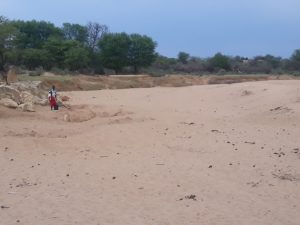
Dry conditions and extreme heat are changing natural wildlife habitat and behavior. Credit: Ignatius Banda/IPS
By Ignatius Banda
BULAWAYO, Zimbabwe, May 17 2024 – Rising temperatures are being blamed for an increase in human-wildlife conflicts in Zimbabwe as animals such as snakes leave their natural habitat earlier than usual.
High temperatures have also given rise to early fire seasons, driving wild animals into human-populated areas, authorities say, placing the lives of many in danger in a country with already compromised health services.
This is also happening at a time when agencies such as the World Health Organization are highlighting the link between climate change and health and calling for increased research.
Globally, unprecedented high temperatures are being blamed for devastating wildfires, and low income African countries such as Zimbabwe that are bearing the brunt of climate change have not been spared.
At the beginning of the year, Zimbabwe’s health ministry reported a spike in the number of snake bites as snakes moved into areas inhabited by humans.
Residents witnessing the upsurge of snakes within residential areas say this has coincided with extreme heat being experienced across the country, while snake catchers in the country’s cities are also recording booming business.
Wildlife authorities say disappearing natural habitat for wildlife has led to increasing endangerment for humans, while climate researchers have noted a link between rising temperatures and snake attacks.
The Zimbabwe National Parks and Wildlife Authority (Zimparks) says brumation, the period snakes spend in hibernation, has been shortened by extended, unusually high temperatures as snakes move from their hiding places earlier than during normal seasonal temperatures.
Shorter winters and longer days have also become normal in a rapidly changing global climate, researchers note, forcing wildlife to adapt and, in some circumstances, move to human-populated areas.
This has led to a record number of snake bites, says Tinashe Farawo, the parks and wildlife spokesperson.
High temperatures in Zimbabwe are also being blamed for extended fire seasons as dry conditions provide ideal conditions for the spread of veld fires.
And as the veld fires spread, dangerous wildlife such as snakes seek safety elsewhere, further endangering the lives of humans, Zimparks officials say.
Affected communities, however, find themselves in a fix regarding how to deal with this climate driven phenomenon.
It is a punishable offence in Zimbabwe to kill wildlife and protected snake species even when humans feel their lives are threatened, highlighting the impact and complexity of climate change on biodiversity and ecological balance.
“As ecosystems change, people and wildlife roam farther in search of food, water and resources. The issue of human-wildlife conflict in Zimbabwe is increasingly gaining traction,” said Washington Zhakata, climate change management director in the environment ministry.
“Rising temperatures are affecting vegetation, food sources, access to water and much more. Ecosystems are gradually becoming uninhabitable for certain animals, forcing wildlife to migrate outside of their usual patterns in search of food and liveable conditions,” Zhakata told IPS.
Zimbabwe has in recent months registered record high temperatures that have affected everything from crops to people’s health, at a time when global temperatures have also soared, triggering a raft of environmental, social, economic, and health challenges.
Researchers have noted that global warming has over the years disrupted biodiversity, forcing wildlife to move to more habitable regions, and, in the process, upsetting natural ecosystems.
“In many parts of sub-Saharan Africa, during periods of drought, people and their livestock are competing with wildlife for diminishing resources,” said Nikhil Advani, senior director of wildlife and climate resilience at the World Wildlife Fund.
Amid the challenges brought by climatic shifts, experts say improved interventions are needed to navigate increasing human-wildlife conflict.
Despite all evidence, least-developed countries such as Zimbabwe have struggled to mobilize and channel resources towards climate management programmes, exposing both humans and wildlife to open conflict.
“There are a number of interventions that can help mitigate human-wildlife conflict, for example, predator-proof bomas (safe areas) and early warning systems for wild animals in the area. One key thing is that communities need to see the benefits of living with wildlife,” Advani said.
While Zimbabwe has the Communal Areas Management for Indigenous Resources (CAMPFIRE) aimed at helping address issues such as human-wildlife conflict, broader issues that include the impact of climate change on ecology remain unaddressed, affected communities say.
“Initiatives like eco-tourism are an excellent way for communities to see the benefits of living with wildlife, as long as the tourism ventures have strong inclusion of local communities throughout the value chain,” Advani added.
With climate researchers warning that the globe will continue warming, concerns linger about the long-term impact of climate change on human-wildlife conflict as communities struggle to normalize cohabiting with dangerous animals.
“Already today we face an exponential increase, compared to 30 years ago, in climate and weather-related natural disasters. These disasters are causing catastrophic loss of life and habitat for people, pets, and wildlife,” Zhakata said.
IPS UN Bureau Report